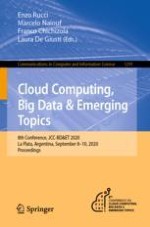2020 | Book
Cloud Computing, Big Data & Emerging Topics
8th Conference, JCC-BD&ET 2020, La Plata, Argentina, September 8-10, 2020, Proceedings
Editors: Dr. Enzo Rucci, Marcelo Naiouf, Franco Chichizola, Laura De Giusti
Publisher: Springer International Publishing
Book Series : Communications in Computer and Information Science
